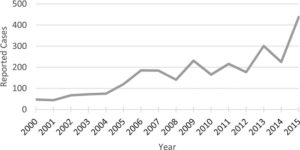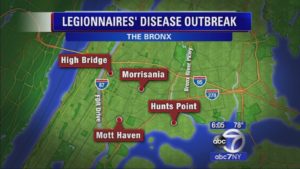Legionnaires’ disease and Pontiac fever outbreaks occur when two or more people are exposed to Legionella in the same place and get sick at about the same time! Outbreaks are commonly associated with buildings or structures that have complex water systems, like hotels and resorts, long-term care facilities, hospitals, and cruise ships. These are high population environments
These structural places use water shared with other people from the main water line. Examples apartment buildings, hospitals, cruise ships, etc… The most likely sources of infection include water used for showering, hot tubs, decorative fountains, and cooling towers (structures that contain water and a fan as part of centralized air cooling systems for a building or industrial processes).
Legionnaires’ disease and Pontiac fever outbreaks can be difficult to identify. Sometimes people travel to a common location, are exposed to Legionella, and then return home before becoming sick. State, territorial, and local health departments take the lead in investigating outbreaks. They also identify control measures to remove Legionella from the water identified as the source of infection. CDC is only involved in outbreak investigations when a health department requests additional assistance.
On July 17, 2015, the Bureau of Communicable Disease of the New York City (NYC) Department of Health and Mental Hygiene (DOHMH) detected an abnormal number and distribution of Legionnaires’ disease (LD) cases in the South Bronx. This cluster of cases would eventually grow into the largest outbreak of LD in NYC history.
PBS.org states that “New York City is facing the largest outbreak of Legionnaires’ disease in its history.
The airborne respiratory disease has killed 10 people since early July, with 100 cases reported. So far, it’s been limited to the city’s South Bronx neighborhood.” So it is in contained area.
NYC.gov documents the following “In 2017, most Legionnaires’ disease cases (26%) occurred in Queens; however, the Bronx had the highest rate (7.0 cases per 100,000 people).” So remember this is not new and at least yearly checked upon situation to prevent epidemics. No panic is needed.
The CDC states today regarding the most recent information about Legionnaires is the following:
Legionella can cause Legionnaires’ disease and Pontiac fever, collectively known as legionellosis.
Scientists named the bacteria after an outbreak in Philadelphia in 1976. During that outbreak, many people who went to an American Legion convention got sick with pneumonia (lung infection).
Health departments reported nearly 10,000 cases of Legionnaires’ disease in the United States in 2018.1 However, because Legionnaires’ disease is likely underdiagnosed, this number may underestimate the true incidence. A recent study estimated that the true number of Legionnaires’ disease cases may be 1.8–2.7 times higher than what is reported.2
About one in 10 people who gets sick from Legionnaires’ disease will die.2,3
People can get Legionnaires’ disease or Pontiac fever when they breathe in small droplets of water in the air that contain Legionella.
In general, people do not spread Legionnaires’ disease to other people. However, this may be possible under rare circumstances.3,4
Legionella occurs naturally in freshwater environments, like lakes and streams. It can become a health concern when it grows and spreads in human-made building water systems.”
(https://www.cdc.gov/legionella/fastfacts.html)
updated 11/21/2023 by Strive for Good Health

